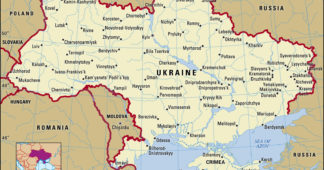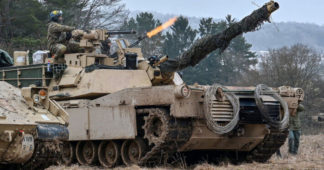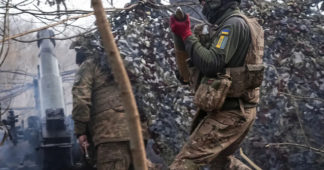By
Feb 16, 2024
A new report obtained by Newsweek has outlined the argument for the United States to play a greater role in pushing for a negotiated settlement to the end of the Russia-Ukraine war as the conflict approaches its two-year mark.
The 43-page paper, published by the Quincy Institute for Responsible Statecraft and authored by former CIA analyst George Beebe and Eurasia expert Anatol Lieven, seeks to dispel the notion that diplomacy is entirely untenable despite the ongoing violence and vast gaps between the interests of the two warring sides.
Beebe and Lieven also outline why they believe such a solution is urgent.
“Conventional wisdom holds that a negotiated end to the Ukraine war is neither possible nor desirable. This belief is false,” the authors assert. “It is also extremely dangerous for Ukraine’s future. The war is not trending toward a stable stalemate, but toward Ukraine’s eventual collapse.”
Though Ukraine’s initial resistance to Russia’s invasion on February 24, 2022, captivated the world with major counteroffensives and a broad sanctions campaign led by Western powers sought to isolate Moscow from global trade, the report warns that both the military and economic pressure on the Kremlin has waned considerably.
Today, “Ukraine’s best hope lies in a negotiated settlement that protects its security, minimizes the risks of renewed attacks or escalation, and promotes broader stability in Europe and the world,” according to the report.
A Precarious Stalemate
Tales of widespread mismanagement, weak intelligence and poor planning have deeply hampered Russia’s once-exalted image as a leading military power since the beginning of the conflict. But as the war raged on, the report notes that Moscow has made efforts to address these shortcomings and capitalize on some of the advantages it still enjoys.
Russian recalculations identified by the report include improving tactics, expanding electronic warfare and vastly increasing the size of its ground force on the battlefield, from around 180,000 troops in February 2022 to roughly 450,000 as of last December.
The authors also highlight the vast manpower disparity—141 million people in Russia to an estimated 36.7 million in unoccupied Ukrainian territory—that haunts Kyiv as it continues to sustain losses, even if they are at a lower rate than their foe.
The report also suggests that Russian weapons have proven better at defending than in offensive maneuvers, a potentially crucial element given the virtual stalemate that has emerged on the ground. A number of Ukrainian villages, towns and cities—most recently Avdiivka—have garnered attention for being the site of months-long battles. However, the report presents data showing that despite the mass bloodshed, not a single percentage of territory changed hands last year.
“As things stand at present,” the authors wrote, “if either side in the Ukraine War eventually cracks, it seems likely to be Ukraine.”
The Limits of Unlimited Support
While Ukrainians alone have led the charge against Russia on the battlefield, Western powers have amassed substantial military and economic assistance in support of Kyiv.
The issue has increasingly emerged as a center of political debates, particularly in Washington, where a $60 billion aid package to Ukraine was tied together with support for Israel and Taiwan and became mired in partisan clashes over the role of U.S. foreign policy versus the priority of domestic concerns.
“In the United States, Ukraine has been trapped in Congressional gridlock despite
warnings of imminent collapse of key military capabilities,” the report states. “Even if this gridlock is temporarily broken for a new aid package, current difficulties are a grim sign for the reliability of future assistance.”
Nearly $160 billion has been pledged in support of Kyiv since the war began, and the government expects a 2024 budget deficit of around $43 billion that would further need to be covered by Western aid, according to the report. The authors also point to World Bank estimates that place the cost of rebuilding Ukraine today at more than $400 billion.
Prospects for Peace
Since direct talks between Russia and Ukraine collapsed in the early stages of the conflict, a number of initiatives led by Turkey, China, Brazil and African nations have manifested in an attempt to bring the two sides to the table.
The authors of the report acknowledge that a solution is not readily identifiable and that “the obstacles to such an endeavor are formidable,” especially as Russia “has no compelling short-run need to compromise with Ukraine and the West anytime soon, as it has reasons at present to believe continued fighting will improve its position.”
At the same time, the report suggests that, beyond the war, “Russia has long-term security interests that could be advanced more effectively through a negotiated settlement than by continual warfare and complete exclusion from the European security order.”
One prerequisite to bringing the Kremlin to the negotiating table, according to the report, would be designing Ukrainian aid to preserve the current battlelines rather than driving Russian forces off of Ukrainian territory altogether. The second would be rekindling direct communications between Washington and Moscow, particularly back channels, as made famous during the Cuban Missile Crisis.
To checkmate potential Russian hesitance in engagement, the report advocates for the U.S. to enlist the support of other non-Western powers. Specifically, these include influential nations of the Global South, such as Brazil and South Africa, as well as Russia’s top strategic partner, China, which is also the U.S.’s leading rival.
Washington and Beijing’s rivalry has only worsened over the past decade, but a recent thaw in relations may present an opportunity that the authors of the report believe could be beneficial to both sides.
“While China is no doubt pleased that assistance to Ukraine has drained American stockpiles of weaponry that might otherwise be available for defense of Taiwan,” the report says, “continued fighting will only incentivize expanded military production in the United States and Europe.”
As for Moscow, “the biggest incentive for Russian compromise would be geopolitical: the prospect of gradually regaining a recognized diplomatic role in European security affairs that would reduce its dependence on China and provide greater geostrategic autonomy in dealing with both West and East,” according to the report.
What a Deal Looks Like
The report argues that any peace deal, as intangible as it may seem, would have to address at least three key objectives of Ukraine, Russia, the U.S., and Europe, respectively.
“For Ukraine, this means reliable assurances that it will not be vulnerable to another Russian invasion and has a viable path to reconstruction and economic prosperity,” the report states. “For Russia, this means reliable assurances that Ukraine will not be an ally of the United States or host NATO weapons or forces.”
“For the United States and Europe,” the report adds, “this means reliable assurances that Moscow will not parlay military success in Ukraine into broader threats to Russia’s neighbors or to NATO member states.”
Recommended initiatives include ceilings that could be established on Russian and Ukrainian weapons deployed to designated zones, along with mutual inspection measures. Also addressed is the crucial issue of territory, which the authors argue could be modeled on ceasefire lines established in Cyprus and the Korean peninsula.
The authors concede, however, that “it is impossible to predict in advance the details of a settlement.”
“Even if the U.S. embarks seriously on an effort to create a path to negotiations, the process of compromise will not be easy or simple,” the authors conclude. “But the alternatives – for Ukraine and the world – will be far worse.”
We remind our readers that publication of articles on our site does not mean that we agree with what is written. Our policy is to publish anything which we consider of interest, so as to assist our readers in forming their opinions. Sometimes we even publish articles with which we totally disagree, since we believe it is important for our readers to be informed on as wide a spectrum of views as possible.











